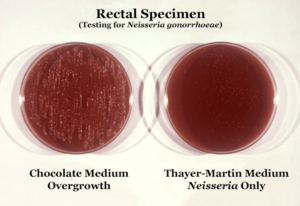Thayer-Martin agar
Thayer-Martin agar (or Thayer-Martin medium, or VPN agar) is a Mueller-Hinton agar with 5% chocolate sheep blood and antibiotics. It is used for culturing and primarily isolating pathogenic Neisseria bacteria, including Neisseria gonorrhoeae and Neisseria meningitidis, as the medium inhibits the growth of most other microorganisms. When growing Neisseria meningitidis, one usually starts with a normally sterile body fluid (blood or CSF), so a plain chocolate agar is used. Thayer-Martin agar was initially developed in 1964, with an improved formulation published in 1966.[1][2][3]

Known as overgrowth, note that the non-selective chocolate agar medium on the left, due to its composition, allowed for the growth of organismal colonies other than those of Neisseria gonorrhoeae, while the selective Thayer-Martin medium on the right, containing antimicrobials that inhibit the growth of organisms other than N. gonorrhoeae, shows no overgrowth, but is positive for N. gonorrhoeae bacteria.
Components
It usually contains the following combination of antibiotics, which make up the VPN acronym:
- Vancomycin, which is able to kill most Gram-positive organisms, although some Gram-positive organisms such as Lactobacillus and Pediococcus are intrinsically resistant
- Polymyxin, also known as colistin, which is added to kill most Gram-negative organisms except Neisseria, although some other Gram-negative organisms such as Legionella are also resistant
- Nystatin, which can kill most fungi
Clinical implications
A negative culture on Thayer-Martin in a patient exhibiting symptoms of pelvic inflammatory disease most likely indicates an infection with Chlamydia trachomatis.
References
- "THAYER-MARTIN Agar (Base)".
- THAYER JD, MARTIN JE (January 1964). "A SELECTIVE MEDIUM FOR THE CULTIVATION OF N. GONORRHOEAE AND N. MENINGITIDIS". Public Health Rep. 79: 49–57. PMC 1915495. PMID 14105729.
- Thayer JD, Martin JE (June 1966). "Improved medium selective for cultivation of N. gonorrhoeae and N. meningitidis". Public Health Rep. 81 (6): 559–62. doi:10.2307/4592771. JSTOR 4592771. PMC 1919807. PMID 4957043.